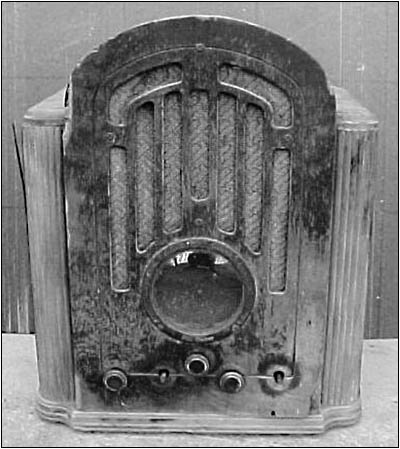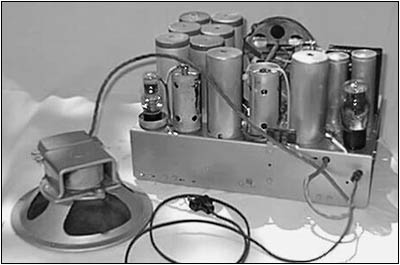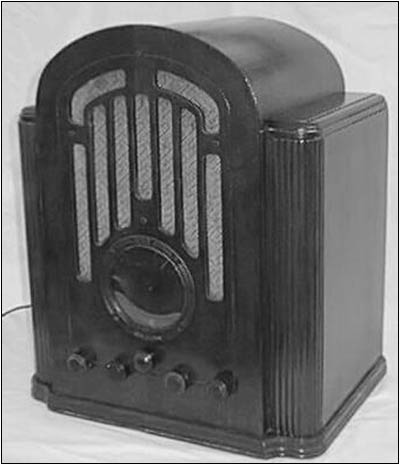Of Old Radios And Related Items--Published Monthly
Restoring an RCA Model 128
BY JOHN HAGMAN
Web Edition
As a collector, John Hagman calls himself an "Antique Radio Archeologist." He's interested in the "diamond so rough it shines only in my mind's eye." In the following article, he describes bringing a basket case back from the grave, a process about 40 of his display sets have gone through. (Editor)
When I saw the RCA 128 on eBay, I couldn't resist the challenge. It's really cool looking, and I have a weakness for RCAs and honking big tombstones. I already own an RCA 262 console, as well as a mess of T-series tombstones. I love them all.
This set uses the full size coil cans from consoles, as well as the inimitable early 1930s RCA dark red dial that you need an arc lamp behind to read. It is a 1935 model and has the following tube types: 6D6, 6A7, 6D6, 6B7, 41, and 80. It covers the AM broadcast band through 18 MHz in three bands.
The Cabinet
As Figure 1 shows, the cabinet had a lot of water damage. The sides and front were quite separated. I made two "shoes" or lasts, one using sign board for inside the whole face and another that fit the face outside to match. I drilled these for 1/4" carriage bolts that fitted through the grille and knob openings. This makes a perfect press that relaminates the face and bars all at once. I cleaned up the glue later, and then reapplied the press to add patches to the face.

Figure 1. The cabinet of the RCA shows the extent of the water damage that required much hard labor to undo.
On the less visible sides, I used Plasticwood to fill in small areas (I used a little on the face too), scribing little grain lines in them. These lines darken when stained. I obtained veneer patches from an old Philco 20.
After much sanding, I stained the whole cabinet with Minwax dark walnut. RCA covered nearly the entire radio in walnut, but the shoulders and base are poplar pieces. After the stain had dried, I masked off these poplar areas and applied toner thoroughly.
Then came ten coats of gloss and three of satin lacquer. I lay my radios on their backs to apply a few extra thick coats of lacquer. This helps to keep the lacquer from running. After 10 days drying, I leveled the surface with 600 and then 1200 grit paper. I finished off with #0000 steel wool and white Scotchbrite for a final high polish.
The Chassis
Meanwhile, I used Naval Jelly to clean the chassis and washed the whole thing in the sink, being careful to keep water out of the cans. However, I rinsed the entire filthy underside with the spray hose. I can't recommend this whole treatment in general, but I did get away with it.
Next, I put chassis on the stove above the warm pilot area for a few days after drying it with compressed air. I treated the once rusty areas with Extend rust converter just in case, and when this was dry, removed the cans and old electrolytics and carefully masked the chassis.

Figure 2. A view of the restored RCA 128 chassis.
I applied several coats of hammer finish, dull aluminum paint, and later installed the cans after polishing them. The tuning cap had been abused and required bending and fiddling to clear shorts. The volume and tone controls, mounted outboard of the chassis, were in need of repair. The phenolic wafers in the rotors had broken loose from the shafts. After lubricating the lower part of the shafts, I carefully Crazy-glued the phenolic wafers in place at the top (it worked beautifully).
I cleaned the controls inside and reassembled them. I fitted the few rubber covered wires in the set with new spaghetti sleeves after stripping the old rubber, rather than installing new wire. Next, I recapped the set. RCA used scary black stuffed paper capacitors with cryptic markings that have no value and no match to the schematic.
After much head scratching and interpolation of the schematic, I did get the capacitors all replaced and the radio sprang to life. The speaker frame required rust treatment, and the cone needed extensive patching with coffee filter paper and fabric glue. I installed a new fabric-covered reproduction cord and plug, as well as a 3/4-amp fuse and holder. A view of the restored chassis is shown in Figure 2.
The Finished Product
After alignment, the set has amazing selectivity and gain for a 6 banger, even an RCA. I burned in the chassis for many hours, and installed it in the cabinet with a substitute tuning knob until the real one arrives. The restored set is shown in Figure 3. Note the amazing transformation from before to after -- it took a lot of time, but the satisfaction is immense.

Figure 3. This RCA 128 has returned from the grave and joined John Hagman's collection of restored sets.
Hope I've given some helpful tips. It sure has taken a lot of words to tell the tale, but not as many as my drops of sweat. Still, it seems the sweetest victories are the hardest ones, and radios are no exception.
(John Hagman, 190 Park St., #2, Burlington, VT 05401)
John Hagman bought his first set, a Majestic 5A430, for $7 at a Vermont flea market three years ago. Since then he has built up a collection of several dozen sets, mostly cathedrals, tombstones, and high end consoles with an emphasis on Philco. He revels in restoring radios for display that the average collector would part out or the average person might unknowingly throw out. See his Web site at http://home.att.net/~yonny
| [Free Sample] [Books, etc., For Sale] [Subscribe to A.R.C./Renew] [Classified Ads] [Auction Prices] [Event Calendar] [Links] [Home] [Issue Archives] [Book Reviews] [Subscription Information] [A.R.C. FAQ] URL = http://www.antiqueradio.com/Jan02_model128.html Copyright © 1996-2002 by John V. Terrey - For personal use only. Last revised: December 23, 2001. For Customer Assistance please contact ARC@antiqueradio.com or call (866) 371-0512 Pages designed/maintained by Wayward Fluffy Publications
Antique Radio Classified |